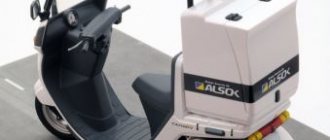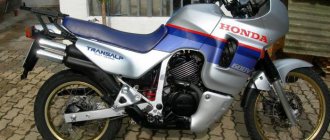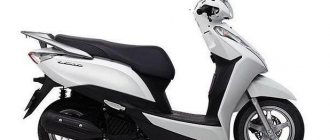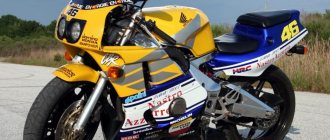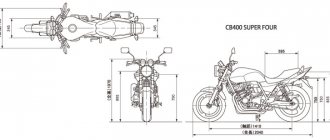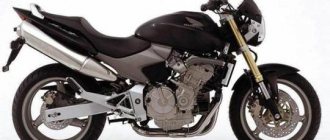On November 17, 1906, the son of a poor Honda blacksmith, Soichiro, was born. His early attraction to technology provided a confident direction for his future. After graduating from school, he moved to Tokyo to work as a car mechanic. Over six years of practice, he gained a lot of experience and managed to save a small amount to open his own small workshop. A young mechanic well versed in technology not only repaired, but also improved the equipment. So in 1928 he received his first patent. Replacing the wooden spokes in the wheel with metal ones. In 1938, he patented his invention, thanks to which he became known to the world. This was the installation of a compression ring on the piston. This continued until its production was bombed during the war. He had to sell what was left and get another job. Experiencing financial difficulties, he did not have enough money for a car. To save money, he attached a motor to his bicycle. Having made several of the same ones at the request of friends, he begins production of mopeds. Founding Honda Motor Company in 1948. Today the concern Honda Motor Co. - the world's largest manufacturer of motorcycles, covering all classes of motorcycles and is the undisputed leader.
In post-war times, getting from one place to another in Japan was difficult. For this reason, the first attempts to create a motorcycle began to appear at Honda. In 1946, the head of the company bought an abandoned building and created the Honda Research Institute there, which was later renamed the Honda Motor Company. This division produced the first full-fledged Honda motorcycle in 1949. Honda motorcycle technology in Russia began to gain popularity by 1961, when the Japanese manufacturer managed to produce at least 100,000 motorcycles per month.
Honda Shadow Motorcycle Series
The Honda Shadow line of motorcycle equipment has been produced since 1983. All motorcycles in this series are outstanding representatives of cruisers.
Technical characteristics of Honda Shadow
Honda shadow motorcycles have excellent characteristics for any motorcyclist who loves motorcycle travel. Almost all representatives of this line of motorcycles are equipped with only V-twin engines. They are liquid cooled. The volume ranges from 400 to 1000 cubic meters. cm.
Each Honda Shadow motorcycle has a cylinder arrangement at an angle of 52 degrees.
Shadow motorcycle range
Since 1989, the following motorcycle models began to appear in the line of motorcycles, including: Honda shadow 1100, shadow vt500, vt700, vt750. In 2011, a 750 cc cruiser remained in the lineup.
Honda Hornet Motorcycle Series
In 1998, the first representative of the Honda Hornet line of motorcycles first appeared on the market. The new CB600F has become a true classic.
Technical parameters of Honda Hornet
Honda Hornet motorcycles have quite acceptable characteristics for city riding. They have been the most influential in the middleweight division for a long time. The design contains sharp lines that are still relevant today.
Fuel consumption is optimal for a city motorcycle. Over time, the Honda Hornet motorcycle has undergone only minor changes, which affected the installation of 17-inch wheels. In 2003, the fuel tank capacity was also increased in the motorcycle line.
In 2007, the Honda Hornet motorcycle appeared before motorcycle fans in an improved guise.
Honda Steed motorcycle series
The Honda brand began producing its stylish cruisers in the Honda Steed lineup in 1993. These choppers were created in a unique American style, which attracted the attention of motorcyclists all over the world.
Parameters of motorcycles of the Honda Steed line
The motorcycles of this model range are distinguished by their sporty elegance. Honda Steed motorcycles have excellent characteristics for city riding. The true classics of the model range are the representatives of the 400 and 600 series. These retro motorcycles have a 31 horsepower engine. The engine type used was 4-stroke. Every Honda Steed motorcycle has a steel frame.
Today, only Steed 400 motorcycles are presented on the market in two trim levels. Gradually, in 1997, Honda stopped producing the Honda Steed 600 motorcycle.
Honda Magna motorcycle series
The iconic motorcycles of the Honda Magna line have been discontinued, but they are still in demand among motorcyclists. Their production began in 1982. Since 2003, production has been discontinued.
The Honda Magna line of motorcycles is one of the most popular cruisers. Each Honda magna motorcycle has characteristics suitable for moving around the city and for long trips. During production, a v-twin engine with a liquid cooling system was used. The engine displacement is 748 cc. Motorcycles of the Honda Magna series are equipped with a five-speed gearbox. Steel is used to make the frame.
Almost every Honda Magna motorcycle has numerous positive reviews. This is due to the fact that they are reliable.
How to read Honda engine markings
The first letter denotes the series. The next two numbers indicate the engine displacement in dm³; their value is rounded up (divide by 10 to get the value in liters). The last letter (A, B, C, Y, Z) denotes the next modification in the series. For older Honda engines, the name consists of two letters, but there is no information about what they mean.
Honda engine table with main characteristics
The table provides a list of Honda engine models by series manufactured from 1990 to the present. In this list, I present all series and models of engines created since the beginning of the history of engine manufacturing at the Honda plant, and only those that are relevant now are engines of the B, D, F, E, H, J, K, L, R, and ZC series . In addition, for each engine the main characteristics are indicated: volume, power, timing belt type and applicability on cars by year of production.
| Motor model | Volume, cm³ | Power indicators, hp | Timing options | Installed on cars | Years of production of the car |
| Serie B | |||||
| B16A | 1595 | 158 | DOHC VTEC | CRX SiR, Integra RSi/XSi | 89/92 |
| 160 | Civic SIR | ||||
| 170 | Civic SiR II | ||||
| B16A1 | 150 | Civic VT | |||
| 160 | Civic SIR | 89/91 | |||
| B16A2 | Civic | 91/00 | |||
| B16A3 | Civic, Civic Del Sol | 94/97 | |||
| B16A4 | 170 | Civic | 96/00 | ||
| B16B | 185 | 97/01 | |||
| B17A1 | 1678 | 160 | SOHC | Integra | 92/93 |
| B18B | 1797 | 140 | DOHC | Domani, Orthia, Integra | 92/97 |
| B18C | 178 | DOHC VTEC | Civic, Integra | 93/98 | |
| B18C | 197 | Integra Type-R | 94/99 | ||
| B18C1 | 170 | Civic, Integra | 94/00 | ||
| B18C3 | Integra Type-R | 95/98 | |||
| B18C4 | 169 | Civic VTi | 97/00 | ||
| B18C5 | 195 | Integra Type-R | |||
| B18C6 | 190 | 96+ | |||
| B18C7 | 195 | ||||
| B18A1 | 1834 | 130 | DOHC | Integra | 90/91 |
| B18A1 | 140 | 92/93 | |||
| B18B1 | 142 | 94/00 | |||
| B20A3 | 1958 | 104 | Prelude | 90/91 | |
| B20A4 | 114 | SOHC 2Carb | Accord, Prelude | 88/92 | |
| B20A5 | 135 | DOHC | Prelude | 88/91 | |
| B20A7 | 150 | 87/92 | |||
| B20A8 | 133 | Accord | 88/92 | ||
| B20A9 | 140 | Prelude | 90/92 | ||
| B20B | 1973 | 150 | Orthia, CR-V, SM-X, Step Wagon | 96/02 | |
| B20B3 | 128-135 | CR-V | 97/02 | ||
| B20B4 | 128 | 97/98 | |||
| B20Z | 150 | SM-X | 96+ | ||
| Series C | |||||
| C20A | 1996 | 145 | V6 2xSOHC 24v | Legend | 85/90 |
| C20A-T | 190 | SOHC V6 TURBO | 88/90 | ||
| C27A | 2675 | 180 | V6 2xSOHC 24v | Accord, Legend | 95/97 |
| C27A1 | 169 | Legend | 87/91 | ||
| C27A2 | 177 | 88/91 | |||
| C27A4 | Accord | ||||
| C30A | 2977 | 270 | V6 VTEC, 2xDOHC 24v | NSX | 91/96 |
| C30A3 | 274 | 91/97 | |||
| C30A4 | 256 | ||||
| C32B | 3179 | 280 | V6, 2xSOHC 24v | NSX | 95/05 |
| C32B2 | 290 | V6 VTEC, 2xDOHC 24v | 98/05 | ||
| C32A | 3206 | 210-235 | V6 SOHC 24v | Acura TL, Legend, Inspire | 90/98 |
| C32A1 | 200 | V6 2xSOHC 24v | Legend | 91/95 | |
| C32A2 | 205 | ||||
| C32A5 | 230 | 93/95 | |||
| C32A6 | 200 | Legend, Acure TL | 91/98 | ||
| C35A | 3474 | 215 | Acura RL, Legend 96 | 96+ | |
| C35A2 | 225 | Acura RL | |||
| Series D | |||||
| D13B2 | 1343 | 75 | SOHC | Civic | 92/95 |
| D13B4 | 95 | City | |||
| D13B7 | 65 | Logo | 99/00 | ||
| D14A1 | 1396 | 90 | SOHC 2Carb | Civic, Concerto | 88/97 |
| D14A2 | SOHC w/o CAT | 88/95 | |||
| D14A3 | 75 | SOHC | Civic | 96/98 | |
| D14A4 | 90 | ||||
| D14A5 | 75 | ||||
| D14A7 | 97/98 | ||||
| D14A8 | 90 | ||||
| D14Z1 | 75 | 99/00 | |||
| D14Z2 | 90 | ||||
| D14Z3 | 75 | ||||
| D14Z4 | 90 | ||||
| D14Z5 | 01+ | ||||
| D14Z6 | |||||
| D15B | 1493 | 105 | SOHC 2Carb | Civic, Civic Shuttle, Capa | 88/95 |
| D15B | 130 | SOHC VTEC | Civic, Domani, CRX | ||
| D15B1 | 75 | SOHC 8V | Civic | 88/89 | |
| D15B2 | 90 | SOHC | Civic, Concerto, Civic Shuttle, CRX | 88/95 | |
| D15B3 | SOHC Carb | Civic | |||
| D15B7 | 105 | SOHC | Civic, Civic Del Sol | 92/95 | |
| D15B8 | 70 | SOHC 8V | Civic | ||
| D15Y2 | 108 | SOHC | 01+ | ||
| D15Y3 | 110 | ||||
| D15Y4 | 90 | SOHC VTEC-E | |||
| D15Y6 | SOHC | 01+ | |||
| D15Z1 | SOHC VTEC-E | 92/95 | |||
| D15Z2 | SOHC | 93/95 | |||
| D15Z3 | SOHC VTEC-E | 95/96 | |||
| D15Z4 | SOHC | Civic, Ballade | 96/00 | ||
| D15Z5 | 115 | Civic | 00 | ||
| D15Z6 | 114 | SOHC VTEC | 96/00 | ||
| D15Z7 | 125 | ||||
| D15Z8 | 115 | 97/00 | |||
| D15Z9 | SOHC | 00 | |||
| D16A | 1590 | Civic, Domani, HR-V, CRX, Acura EL | 90+ | ||
| D16A2 | 130 | Integra | 91/95 | ||
| D16A8 | 122 | DOHC | Integra, Concerto, CRX, Rover 200/400 | ||
| D16A9 | 131 | DOHC w/o CAT | Civic, Concerto, CRX | ||
| D16B2 | 116 | SOHC | Civic | 97/98 | |
| D16B5 | 114 | 98/00 | |||
| D16B6 | 115 | Accord | 99/02 | ||
| D16B7 | 107 | ||||
| D16V1 | 110 | SOHC VTEC | Civic | 01/05 | |
| D16V2 | |||||
| D16V3 | |||||
| D16W1 | 105 | SOHC | HR-V | 99/02 | |
| D16W2 | |||||
| D16W3 | 115 | Civic | |||
| D16W4 | 125 | SOHC VTEC | |||
| D16W5 | HR-V | ||||
| D16W7 | 110 | Civic | 01/05 | ||
| D16Y1 | 131 | 93/95 | |||
| D16Y2 | 126 | Civic | 95/96 | ||
| D16Y3 | 113 | SOHC | |||
| D16Y4 | 115 | SOHC VTEC-E | 96/00 | ||
| D16Y5 | 114 | ||||
| D16Y6 | 125 | ||||
| D16Y7 | 105 | SOHC | Civic, Civic Del Sol | ||
| D16Y8 | 127 | SOHC VTEC | |||
| D16Y9 | 106 | SOHC | Ballade | ||
| D16Z1 | SOHC 2Carb | concerto | 90/92 | ||
| D16Z2 | 112 | SOHC | Concerto, Civic Shuttle, Rover 200/400 | 91/95 | |
| D16Z4 | 122 | DOHC w/o CAT | Civic, Concerto | 90/95 | |
| D16Z5 | 124 | DOHC | CRX | 89/91 | |
| D16Z6 | 125 | SOHC VTEC | Civic, Civic Del Sol | 92/96 | |
| D16Z7 | 123 | SOHC | 92/00 | ||
| D16Z9 | 125 | SOHC VTEC | Civic | 94/95 | |
| D17A1 | 1668 | 115 | SOHC | 01+ | |
| D17A2 | 125 | SOHC VTEC | Civic, Stream | ||
| D17A5 | 130 | Civic | |||
| D17A6 | 115 | ||||
| D17A7 | 100 | SOHC VTEC (NATURAL GAS) | |||
| D17A8 | 120 | SOHC | |||
| D17A9 | 125 | SOHC VTEC | |||
| D17Z1 | 102 | SOHC | |||
| D18A1 | 1797 | 130 | Integra | 92/93 | |
| D18B1 | 142 | 94/98 | |||
| D18C1 | 170 | DOHC VTEC | Civic | 94/99 | |
| D18C4 | 95/97 | ||||
| D18C5 | 190 | 97/99 | |||
| Series E | |||||
| E07A | 656 | 38-64 | SOHC | Acty, Acty Van, Street | 90/97 |
| E07Z | 45-64 | Acty, Acty Van, Beat, Life, Vamos, That's, Z | 90+ | ||
| ECA | 995 | 70 | SOHC VTEC-E | Insight | 99+ |
| Series F | |||||
| F18A2 | 1797 | 99 | SOHC 2Carb | Accord | 90/91 |
| F18A | 1850 | 105 | SOHC Carb | Accord, Ascot | 89/93 |
| F18A | 115 | SOHC | Accord | 95 | |
| F18A3 | 116 | ||||
| F20A | 1997 | SOHC Carb | Accord | 89/93 | |
| SOHC | 90/94 | ||||
| 110-150 | DOHC | Ascot | 89/95 | ||
| F20A2 | 110 | SOHC 2Carb | Accord | 90/93 | |
| F20A3 | 106 | ||||
| F20A4 | 133 | SOHC | Accord, Prelude | ||
| F20A5 | 135 | Accord | |||
| F20A6 | 90 | SOHC 2Carb | |||
| F20A7 | 133 | SOHC | 91/93 | ||
| F20A8 | 92/93 | ||||
| F20B3 | 136 | 94/97 | |||
| F20B5 | 147 | 99/02 | |||
| F20B6 | |||||
| F20C | 241 | DOHC i-VTEC | S2000 | 99+ | |
| F20Z1 | 131 | SOHC | Accord | 93/96 | |
| F20Z2 | 116 | ||||
| F20Z3 | 133 | 93/97 | |||
| F22A1 | 2156 | 135 | SOHC | Accord, Prelude | 90/96 |
| F22A3 | 150 | Accord | 90/93 | ||
| F22A6 | 130 | Accord, Prelude | 92/95 | ||
| F22A7 | 150 | Accord | |||
| F22A8 | 147 | ||||
| F22B1 | 145 | SOHC VTEC | Accord, Acura CL | 94/97 | |
| F22B2 | 130 | SOHC | Accord | ||
| F22B5 | 150 | ||||
| F22Z2 | |||||
| F23A1 | 2254 | SOHC VTEC | Accord, Acura CL | 98/99 | |
| F23A4 | Accord | ||||
| F23A5 | 135 | SOHC | |||
| Series G | |||||
| G25 | 2451 | 176 | Saber, Inspiration | 95 | |
| G25A1 | Vigor | 94 | |||
| G25A4 | Acura TL | 96 | |||
| Series H | |||||
| H22A | 2157 | 200 | DOHC VTEC | Prelude (Japan) | 93/96 |
| Prelude SiR | 97/01 | ||||
| 220 | Prelude Type-S, (RedHead) Accord Euro-R, Prelude Type-S, Prelude SiR S-Spec | ||||
| H22A1 | 190 | Prelude | 93/96 | ||
| H22A2 | 185 | 94/96 | |||
| H22A4 | 190 | 99/01 | |||
| H22A5 | 185 | 97/01 | |||
| H22A7 | 212 | Accord Type-R/RedHead) | 98/01 | ||
| H22A8 | 200 | Prelude (Euro) | |||
| H23A | 2259 | DOHC | Accord | 92/96 | |
| H23A1 | 160 | Prelude | |||
| H23A2 | |||||
| H23A3 | 158 | Accord | 93/96 | ||
| Series J | |||||
| J25 | 2495 | 200 | V6 VTEC, 2xSOHC 24v | Saber, Inspire, Legend | 95 |
| J25A | 2451 | Saber, Inspiration | |||
| J30A1 | 2977 | 203 | Acura CL | 98/03 | |
| J30A2 | Acura CL, Accord | ||||
| J32A2 | 3179 | 260 | Acura TL, CL | 97+ | |
| J35A | 3474 | 257 | Pilot | 96+ | |
| 300 | Legend | ||||
| J35A1 | 210 | Acura RL, Odyssey | 98+ | ||
| J35A3 | 240 | MDX, Saturn Vue | |||
| Series K | |||||
| K20A | 1998 | 155 | DOHC i-VTEC | Integra | 99 |
| 220 | Integra, Acura RS-x | ||||
| K20A2 | 200 | Acura RS-x | |||
| K20A4 | 150 | CR-V | 02+ | ||
| K20A6 | 155 | Accord, Stream | 02/ | ||
| K20Z | 200 | Civic Si | 06/- | ||
| K24A | 2354 | 190 | DOHC i-VTEC | Accord, Element, CR-V | 02+ |
| K24A2 | 200 | Acura TSX | 03+ | ||
| Series L | |||||
| L12A | 1246 | 78 | SOHC | Jazz | 02+ |
| L13A | 1339 | 86-115 | City, Fit, Jazz, Mobilio | ||
| L15A | 1496 | 90-110 | |||
| Series R | |||||
| R16A1 | 1595 | 125 | SOHC i-VTEC | Civic | 06/- |
| R18A1 | 1798 | 140 | |||
| R20Z2 | 1998 | 155 | DOHC i-VTEC | Civic VTi | |
| ZC Series | |||||
| ZC | 1590 | 120 | SOHC | Ballade, Civic, Integra | 84/01 |
| 130 | SOHC 2Carb | Civic, Concerto, Integra | 88/92 | ||
| SOHC VTEC | Civic, Domani | 92/94 | |||
| ZC1 | 125 | SOHC | Integra | 84/01 | |
Honda Fireblade motorcycle series
The debut of the motorcycle line took place in 2004. The first representative was the CBR 1000. Throughout the world, this motorcycle was known as the Fireblade. The new product replaces the legendary Honda CBR 600 RR.
The new Honda fireblade motorcycle had the following differences from its predecessor:
- the location of the fuel tank has changed, which was moved to the central part,
- In the new product, the size of the wheelbase has increased by 5 millimeters.
The fireblade uses a four-cylinder engine with a displacement of 998 cubic centimeters. The updated 2004 model features a six-speed manual transmission.
In 2006, the Honda Fiereblade motorcycle underwent some changes, which are presented:
- reducing the weight of the motorcycle,
- increasing engine power.
Fourth generation RK1, RK2, RK3, RK4, RK5, RK6, RK7, RK8 2009-2015
The fourth generation of Hondaq Stepwgn is a redesign of the previous one. The new car has increased in height and length, but remains the same width. Honda has brought back the Spada trim level for this generation, with a unique grille and headlights.
There was only one engine left, a 2-liter, but this is no longer a K20A, but a new R20. The unit is reliable, has an i-vtec variable valve timing system, if you compare it with the K20A, it has become more civilian, it has good traction at low and medium speeds, but at the same time it has lost its sporty character.
It comes with a classic automatic transmission with a torque converter and a CVT. Out of habit, the Stepwagon has both all-wheel drive and front-wheel drive. A car with a classic drive has the smallest appetite in this class, only 7 liters per 100 km.
The minivan has a low center of gravity, which affects interior space and handling.
The interior of the Honda Stepwagon is spacious and functional, there is a lot of space in the luggage compartment, and if you need more, you can fold the rear seats into a separate hole located in the floor.
The minibus turned out to be comfortable, the pre-sale slogan can confirm this, it sounds: “Comfort for everyone!” Honda has always been able to use useful space wisely, and in the Stepwagon every centimeter is thought out. The interior dimensions are the largest among competitors (length: 3095 mm, width: 1395).
In 2012, the Honda Stepwagon was changed in appearance, they began to install a new radiator grille, new bumper, different taillights and rims. A parking camera was included in all trim levels. The updated appearance helped improve the aerodynamics of the body, which reduced fuel consumption by 10%.
The seat belt for the second and third rows of the center seat has been changed from a two-point to a three-point type. The color range of the body has been expanded.
Technical characteristics of the Honda Stepwagon
• Manufacturer: Honda • Production: 2009 – 2015 • Drive: front-wheel drive and 4WD • Transmission: 5-speed automatic classic type, CVT with torque converter for front-wheel drive versions. • Engine: R20A, 150 hp 6200 rpm 193 Hm 4200 rpm, • Length: 4,690 • Width: 1,695 • Height: 1,815 • Ground clearance: 155 • Wheelbase: 2855 • Fuel consumption per 100 km: 7 l per 100 km/h for front-wheel drive versions, for 4WD 9 l per 100 km/h • Curb weight: 1580 kg (dimensions in mm)
Price
In Russia there is a large selection of Honda StepWGN, prices for the 4th generation start from 650 thousand rubles and can reach up to 1,200,000 rubles, but this will already be the Stepwagon Spada 4WD configuration, there is no analogue with left-hand drive, the car was not exported.
Video
Comparison with competitor Nissan Serena
Honda Gold Wing motorcycle series
The Honda Gold Wing motorcycle is the type of motorcycle that not every motorcycle enthusiast can afford to purchase. Its cost is very high and ranges from 25 thousand dollars. It should be noted that the Honda gold wing motorcycle can easily replace a car. Two people can easily go on a long journey on it.
The Honda gold wing motorcycle has the following characteristics:
- four-stroke engine with two valves per cylinder,
- engine displacement is 1832 cubic centimeters,
- engine power is 118 horsepower,
- The weight of the motorcycle is 413 kilograms.
The Honda Goldwing motorcycle belongs to the luxury category. No one will remain indifferent to its elegant design. Almost every motorcyclist in the world is attracted by the smoothness of its lines.
Honda Africa Twin motorcycle series
Enduro motorcycles attract motorcycle enthusiasts. The prototype of the modern Honda Africa Twin motorcycle is a heavy enduro, created in 1982. In 1988, Honda released a production version of this type of motorcycle technology. Initially, the company used an engine with a displacement of 750 cubic centimeters.
Almost all the time of its existence, Africa Twin had positive reviews. However, even despite this, 15 years after the start of production of motorcycles of this model range, the company decided to discontinue it. This decision was made because the Honda Africa motorcycle had become morally irrelevant for consumers and the brand.
So the Africa Twin motorcycle became a thing of the past for the reason that there was no place for it on the market. However, to replace it, the company began producing new enduros.
Fifth generation Honda Stepwagon RP1, RP2, RP3, RP4 2015-present
The fifth generation Honda Stepwagon began selling in April 2015, the model has changed both externally and technically.
Changes affected the power unit; the 2-liter engine gave way to a 1.5-liter L15B turbo engine.
The 1.5-liter turbocharged engine provides torque at low speeds as if it were 2.4 liters, and at high speeds the VTEC valve timing system still works. In addition, with this “heart”, the Honda Stepwagon consumes less fuel.
A new “heart” is combined with a variator and, as always, the buyer has a choice of all-wheel drive or front-wheel drive.
What is the most important thing in a passenger minibus? Spacious and functional interior! So the Honda StepWGN traditionally has the most spacious interior among its classmates, and probably the most functional.
As on the previous version, the third row of seats folds flat into the floor, there are many containers in the cabin, everything is done wisely and for the convenience of passengers.
The rear door has a convenient design; it can be opened upwards or halfway to the side. The photo below shows the mechanism. (available as an additional option)
The minivan is equipped with new technologies that help the driver while driving and, naturally, the list of options includes the “Honda Sensing” safety system, which includes a radar and a camera on the windshield.
The radar, which is installed in the car emblem, recognizes objects and pedestrians. And the camera on the windshield determines the parameters and height of a person at a distance of up to 60 meters!
For example, if you are driving a Honda StepWGN and a pedestrian enters the roadway, the security system automatically, in a matter of seconds, calculates the likelihood of a collision and begins to warn you of the danger with an audible signal and a visual image.
It can also automatically apply the brakes and operate the steering wheel. It also has collision avoidance and sign recognition functions.
All modifications have a lift assist function and a stabilization system.
Honda Stepwagon 2021 in a new body, photo, price, specifications
In 2021, the Spada equipment is being modernized beyond recognition, it feels like this is a new generation, but no, it’s just a restyling.
Previously, Spada was distinguished by different bumpers and radiator grille; in 2017, it received LED headlights and a new body design; now it has an aggressive “face.”
A hybrid version has also been added, which has a naturally-aspirated two-liter engine with 146 horsepower and an electric motor with 184 horsepower. Such a power plant is found on the Odyssey and Accord. The hybrid version consumes only 4 liters per 100 km.
The price of the hybrid version is 3, 350, 160 yen, if converted to rubles, it will be 1,774,000 rubles. For Russian buyers, you need to add costs for “customs clearance”.
For basic equipment, prices start at $20 thousand.
There is an interesting configuration, this is a model with a tent. Check out photos of this RV camping site:Specifications
• Manufacturer: Honda • Production: 2015 – • Drive: front and full • Transmission: CVT with torque converter. • Engine: L15B, 150 hp 5500 rpm 203 Hm 5000 rpm, • Length: 4,760 • Width: 1,695 • Height: 1,825 • Ground clearance: 140 • Wheelbase: 2890 • Fuel consumption per 100 km: 6.5 l per 100 km/h • Curb weight: 1700 kg (dimensions in mm)
Price
The Honda Stepwagon is produced only for the domestic Japanese market; it has never been exported, which is why there is no analogue with left-hand drive. Prices for the new StepWGN start at $20 thousand, and the main competitor can be considered the Nissan Serena.
Video
Video about the updated Honda Stepwagon: Spada 2017
Honda Valkyrie motorcycle series
Honda Valkyrie motorcycles belong to the category of heavy cruisers. The first representative of this model range appeared in 1996. Honda Valkyrie motorcycles have become widespread thanks to the fashion for super-heavy motorcycles.
The Honda Valkyrie motorcycle that appeared on the market immediately attracted the attention of motorcyclists, because in it the manufacturer managed to successfully combine the classic chopper and the power of a power plant inherent in a cruiser. This motorcycle was very popular among motorcyclists all over the world until 2003, when the brand decided to stop its production.
However, the story of this line of motorcycles does not end there. After the cessation of production of the Honda Valkyrie Rune, the company presented its new project, the Honda F6C Valkyrie, at one of the Honda exhibitions in 2009.
Characteristics of Honda / Honda
Honda (Honda Motor Company, Honda Giken Kogyo KK), a Japanese company specializing in the production of passenger cars and motorcycles, various special equipment, as well as a variety of engines. It produces some of its products under the Daihatsu brand. The headquarters is located in Tokyo. Founded in 1946 by the enterprising engineer Soichiro Honda as the "Honda Technical Research Institute" and initially produced small engines and mopeds based on them. In 1948, the Institute was transformed into a company with a modern name, which initially focused on the production of motorcycles that quickly became famous. Since 1949, Takeo Fujisawa, rightfully considered the second founding father of the company, began his work as a member of the company’s Board of Directors. Honda devoted himself entirely to production technology, and Fujisawa to corporate management.
In 1948, the company began producing motorcycles: in 1949, the Dream model was released with a two-stroke 98 cc engine, which embodied all the dreams of its creators. Simultaneously with the release of this model to the market, a new approach to organizing sales was developed: from now on, the company appointed distributors to sell certain products in a certain territory, who in turn developed a dealer network.
The next important step in the history of the company was the creation of a new four-stroke engine (1952) and a new motorcycle (1953) based on it. Already in 1955, it began to lead in annual production volume in the Japanese domestic market.
In 1959, a branch of the company called American Honda Motor Company was created in the USA, and in 1982 the company opened a car production plant in the USA, in Ohio.
Having created a name for itself in the production of motorcycles, in 1962 the company began producing cars. The first to appear was a cargo van, followed by a two-seater sports car.
In 1964, a plant designed for mass production was put into operation. In addition, in 1962, Honda created a plant for the production of equipment for its factories, which would later become the basis
In 1972, with the introduction of the Civic, Honda gained recognition as a manufacturer of compact, inexpensive cars of fairly high quality.
Based on the Civic, the CRX mini sports car was released in 1992. The new two-seater Honda CRX was released in 1994.
A special modification of the Civic station wagon with increased dimensions, Orthia, was first shown in the summer of 1999.
The Accord model is world famous. The first generation of this model was introduced in 1976, initially with a hatchback body. In 1977, production of the Honda Accord sedan began. In the fall of 1998, the sixth generation Honda Accord appeared.
The luxury modification of the Accord model Honda Inspire/Saber was first introduced in September 1989. A new modification appeared in 1995.
The PRELUDE model was first released in 1978. PRELUDE occupies a special place among Honda cars. This is a sports coupe equipped with a powerful engine.
In the 1980s, when almost every company tried to present its own supercar, the Honda NSX model confidently defeated many. Equipped with the latest technical and electronic innovations, this model confidently established the company in the gran turismo class car market. The car went into production in the summer of 1990. In November 1992, a lightweight NSX-R model was created, and in 1995, the NSX-T version with a removable roof was created.
The Honda Integra sedan and coupe were first introduced in February 1985. In the USA, the model is sold under the Acura Integra brand. In the fall of 1997, a higher-performance model was introduced - the Integra Type R - a sports coupe.
The compact car HONDA Life (Today) was released in September 1985. In January 1993, a new generation of Honda Life cars appeared. In April 1997, the Life microvan was launched into production.
In Chicago in February 1989, a prototype of the Honda HR-V, a universal car, was presented, which went into production in the summer of 1990. The modern modification was presented in Tokyo in 1998.
The Legend sedan was first introduced in October, the coupe in November 1990. In 1996, the third generation of the Honda Legend was presented in Geneva. In the USA it is sold under the Acura brand.
In October 1994, the Odyssey minivan (Shuttle in Europe) was introduced. The North American Odyssey, which appeared in late 1998, is noticeably larger in size than the Japanese one. Since the fall of 1999, this car has appeared in Japan, but under the name Lagreat.
In October 1995, the multi-purpose Honda CR-V station wagon was released. The all-wheel drive model has been sold in Europe since the spring of 1997.
At the Tokyo Motor Show in the fall of 1995, the HONDA S-MX minivan was presented. Goes on sale in November 1996. Produced only for the domestic market.
Hoping for good demand among Europeans, in October 1996, after a 12-year break, a new Honda model, the Logo, returned to Europe (previously it was the Honda Jazz).
The fifth generation of the Prelude family, currently in production, went on sale in Europe at the beginning of 1997. The external design of the model corresponds to coupes: long hood, low roof, strict lines.
In March 1999, at the international automobile exhibition in Geneva, the S2000 model was awarded the title “Convertible of the Year”. The release of this car was timed to celebrate the 50th anniversary, celebrated in the fall of 1998. The Honda S2000 is the successor to the first sports car, the Honda S800, released in 1965.
In 1999, the premiere of the two-seater sports coupe Insight took place at the Detroit Auto Show. The European premiere of the production model took place in the fall of the same year in Frankfurt am Main.
At the end of 1999, a new model of the 5-door luxury station wagon Avancier, similar in size to the Inspire/Saber, was introduced to Japanese buyers.
Today the company ranks first in the world in the production of motorcycles and is among the top ten global car manufacturers. In addition, the company's power products (generators, cultivators, lawn mowers, boat engines, etc.) are very popular in the world. Honda now has 119 production plants in 33 countries. In 2000, 2,540,000 cars, 5,160,000 motorcycles, and 4,080,000 units of power products bearing the Honda brand were sold worldwide.
Over the past year, Honda has introduced a new generation of i-series engines and a new "global compact platform" launched alongside the latest Civic.
Website: www.honda-eu.com
Representative office in Russia: www.honda.co.ru
